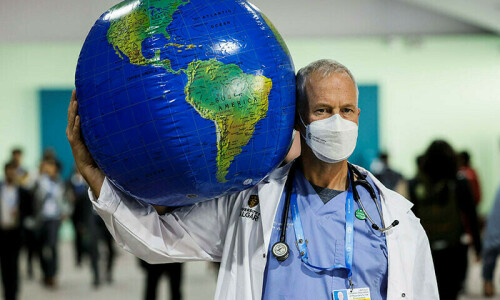THE 69th session of the United Nations General Assembly began last week. At the last minute, construction workers hurried to put finishing touches to the newly refurbished General Assembly Hall from where global leaders would address the world. New carpet, new backdrops and better desks are among the features of a renovation programme costing over $2 billion.
But while the leaders debating the world’s destiny can enjoy their spruced up digs, most of the rest of the world yearns for even rudimentary stability, a place to call home. Last Wednesday, a UN-backed report prepared by the Norwegian Refugee Council’s Internal Displacement Centre revealed that nearly 22 million people were displaced in the year 2013 by climate and weather-related disasters.
The report also revealed that the risk of being displaced by disasters has more than doubled over the last four decades, owing largely to the growth of urban populations of affected countries. The latter, unsurprisingly, are the world’s underdeveloped; 19 million of the world’s 22 million displaced are in Asia.
If the news regarding displacement caused by natural disaster was not in itself enough of a tragedy, more reports, also via the UN, painted a similarly dismal picture of the displacement caused by conflict. A few weeks before the UN General Assembly began, the UNHCR, the UN refugee agency, released its latest assessment of the situation in Syria.
Pakistan’s creation story reflects the central belief that those who migrate and start again can be absorbed.
According to its estimates, roughly half the Syrian population is now displaced. This amounts to about three million people who are now scattered in refugee camps in Turkey, Lebanon, Jordan and other neighbouring countries. Most, it is said, will likely never return home, given the magnitude of the conflict and the irreparable and irreversible changes that it is wreaking on what was once their homeland.
Here in Pakistan, displacement has been tied to the country’s destiny since its birth but this fact of creation seems to have done little in allowing us to conjure up solutions to the problem of those driven from home. In the most recent iterations of the hapless driven from home, the numbers of internally displaced from Fata fleeing the military operation Zarb-i-Azb have, according to the UN, reached one million. For this number of people, the government has established six refugee camps.
Those are the Pakistanis cursed by conflict; the ones cursed by natural calamity have fared no better. The recent floods that ravaged the country killed over 200 and are estimated to have displaced at least 27,000. Several of these thousands were actually lucky, plucked from rooftops just before their fragile houses were swept away by merciless currents.
In the days that have followed, the same trains of local dignitaries have sailed through their ravaged communities. There have been photo ops and televised hugs and handshakes and soon, as there always is, there will be complete forgetfulness.
Pakistan’s creation story places displacement at the centre of destiny and reflects a central belief in the idea that those who migrate and start again can be absorbed, re-rooted and begin again.
It reflects a belief in the permeability of community to absorb newcomers, to create space for them and eventually integrate them in a new formation. This has proven to be untrue in the waves of displacement that have followed independence and in the waves of refugees, whether fleeing conflict or calamity. The fault lines can be seen everywhere in ethnic patterns and linguistic grievances. These are traced in blood as voices demand autonomy if not outright succession.
One reason for this could be the construction of displacement in the global and local imagination as largely a technical and short-term problem, requiring little beyond the fixes of camps and tents and shelters. Indeed, these are required to aid the immediate needs of those who no longer have roofs over their heads; but the larger-term damage is to the communities whose structures have now crumbled.
In societies like Pakistan, where the government itself provides little in terms of security, social services, education and other basic goods, the evisceration of these communities signifies a transformation of social structures, social relations and the ability of people to survive beyond the immediate calamity.
One example of this was recently seen in refugee camps in Jordan, where Syrian families reported girls as young as 12 being married off because they were afraid for their safety in the environment of the camps. Of course, child marriages produce their own issues, and are not only accompanied by reproductive health problems, but also abuse of the girls. With the absence of community interconnections and controls, society itself is weakened and destroyed.
Displacement and destiny, therefore, are connected because uprooting people from one place to another results in the evisceration of identity and community, which, in turn, leads to a weakened, failing society. This is particularly harmful in places like Pakistan, where communities and social norms largely function as the organising principles of life.
The state, always fragile, weak and dominated by a self-interested elite, has never been a stabilising force and nor will it be in the face of these most recent displacements, providing at best the most superficial forms of assistance.
Pakistanis spend much time and many moments wondering about the conundrums of their society, the crimes against women and children, the poor and the weak; all of them are but symptoms created by the routine and repeated destruction of communities, the washing away of the only glue that feebly tries to keep things together.
The writer is an attorney teaching constitutional law and political philosophy.
Published in Dawn, September 24th, 2014











































